LA GRANDE 2 RESERVOIR
An aerial view of the the reservoir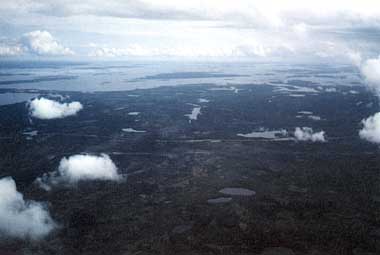
Photo: M. Kislalioglu and F. Berkes
A. LOCATION
Quebec, Canada.53:0-54:0N, 75:5-78:0W; 173.5 m above sea level.
B. DESCRIPTION
La Grande 2 (LG2) Reservoir is a man-made lake, created as part of the La Grande Complex (James Bay) Hydroelectric Project. "Located some 1,000 km north of Montreal, three dams were constructed on La Grande River, starting with LG2, the second largest hydroelectric power station in Canada at 5.328 MW. An additional powerhouse (LG2A), constructed to meet peak power requirements, will increase the installed capacity to 7,326 MW, the largest in Canada. Two major diversions channel extra water from other rivers into La Grande through Opinaca and Caniapiscau Reservoirs" (1).La Grande 2 Reservoir was initiated in November 1978 and took one year to fill. It was constructed by "Societe d'Energie de la Baie James", a crown corporation of Province of Quebec as part of a $ 16 billion (Can $) development project, called La Grande Complex Phase 1.
There is one town, Radisson, near the reservoir. A Cree Amerindian settlement, Chissasibi, is about 100 km by road. The area was used in the past for hunting, trapping and fishing by the Cree people. Hunting and trapping has continued, but the reservoir fisheries were closed down after 1985 due to high mercury levels in fish (2). LG2 dam and the powerhouse is the largest tourist attraction in Northern Quebec (Q).
C. PHYSICAL DIMENSIONS
| Surface area [km2] | 2,136-2,835*1 |
| Volume [km3] | 42.3-61.7*1 |
| Maximum depth [m] | 137 |
| Mean depth [m] | 21.8 |
| Water level | Regulated |
| Normal range of annual water | |
| level fluctuation [m] | 8.7 |
| Length of shoreline [km] | 4,550 (3) |
| Residence time [yr] | 0.5 (4) |
| Catchment area [km2] | |
| (La Grande River) | 97,643*2 |
| (La Grande Complex) | 176,810*3 |
D. PHYSIOGRAPHIC FEATURES
D1 GEOGRAPHICALSketch map: Fig. NAM-28-0l.
Bathymetric map: Fig. NAM-28-02.
Number of outflowing rivers and channels (name): 1 (La Grande R.).
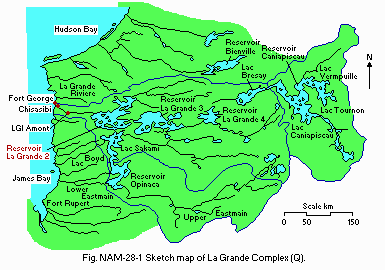
Sketch map of La Grande Complex (Q).
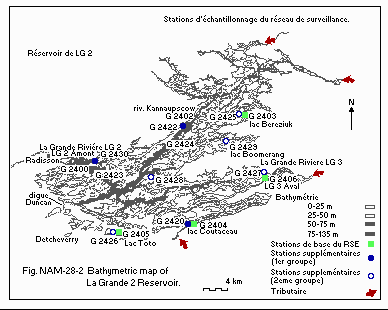
Bathymetric map with location of monitoring stations.
D2 CLIMATIC
Climatic data at Eastmain*, 1951-1980 (3a)
Mean temp. [deg C]
| Jan | Feb | Mar | Apr | May | Jun | Jul | Aug | Sep | Oct | Nov | Dec | Ann. |
|---|---|---|---|---|---|---|---|---|---|---|---|---|
| -20.4 | -19.7 | -12.9 | -2.7 | 5.1 | 11.3 | 13.7 | 13.0 | 9.2 | 3.8 | -4.1 | -15.5 | -1.56 |
| Jan | Feb | Mar | Apr | May | Jun | Jul | Aug | Sep | Oct | Nov | Dec | Ann. |
|---|---|---|---|---|---|---|---|---|---|---|---|---|
| 29 | 16 | 24 | 25 | 40 | 51 | 95 | 73 | 80 | 81 | 70 | 44 | 627 |
Solar radiation (Nitchequon*)[MJ m-2 day-1]
| Jan | Feb | Mar | Apr | May | Jun | Jul | Aug | Sep | Oct | Nov | Dec | Ann. |
|---|---|---|---|---|---|---|---|---|---|---|---|---|
| 3.7 | 7.8 | 13.0 | 18.8 | 19.6 | 19.0 | 17.0 | 14.5 | 9.3 | 5.2 | 3.3 | 2.7 | 11.2 |
Water temperature [deg C](3)
The exit of LG2*, 1980-1985
[m]
| Depth | Jan | Feb | Mar | Apr | May | Jun | Jul | Aug | Sep | Oct | Nov | Dec |
|---|---|---|---|---|---|---|---|---|---|---|---|---|
| S*2 | 0.7 | 0.7 | 0.7 | 0.6 | 1.3 | 3.0 | 6.0 | 8.0 | 8.7 | 7.5 | 4.5 | 1.0 |
Freezing period (1979-1985): 6 December-9 June (3).
Mixing type: Dimictic.
Notes on water mixing and thermocline formation Thermal profile in Fig. NAM-28-03 (3).
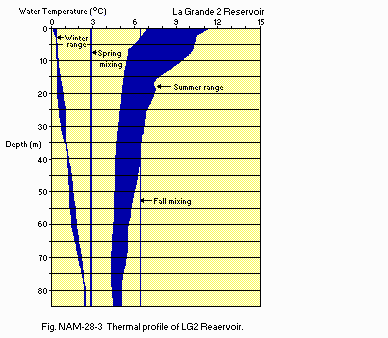
Thermal profile of LG2 Reservoir.
E. LAKE WATER QUALITY (Q)
Mean summer levels of water quality parameters as measured before (1978), during (1979) and after (1980-1984) the filling of La Grande 2 Reservoir at station Toto and in the La Grande Riviere (1984)(2)| La Grande | ||||||||
|---|---|---|---|---|---|---|---|---|
| Parameters | '78 | '79 | '80 | '81 | '82 | '83 | '84 | Riviere '84 |
| True color | 55 | 50 | 52 | 49 | 46 | 43 | 42 | 42 |
| [Hazen unit] | ||||||||
| Turbidity [NTU] | 1.32 | 0.97 | 0.90 | 1.11 | 1.26 | 1.16 | 0.97 | 1.94 |
| Transparency [m] | 1.9 | 2.0 | 1.8 | 1.9 | 1.8 | 1.7 | 2.0 | 1.9 |
| Temperature [¡¦] | 11.2 | 12.6 | 10.6 | 11.3 | 12.5 | 11.6 | 11.7 | 10.7 |
| Dissolved oxygen | 9.9 | 9.0 | 8.0 | 7.3 | 8.4 | 8.9 | 9.1 | 11.9 |
| [mg l-1] | ||||||||
| 02 saturation [%] 91 | 86 | 73 | 66 | 80 | 83 | 84 | 103 | |
| pH | 6.9 | 6.7 | 6.3 | 6.4 | 6.4 | 6.4 | 6.4 | 6.5 |
| Conductivity | 29 | 22 | 22 | 23 | 18 | 17 | 16 | 14 |
| [micro S cm-1] | ||||||||
| Chloride | 9.8 | 1.4 | 1.1 | 1.0 | 0.8 | 0.7 | 0.7 | 0.3 |
| [mg l-1] | ||||||||
| Bicarbonate | 10.0 | 6.7 | 6.0 | 7.0 | 5.1 | 4.8 | 4.2 | 4.0 |
| [mg l-1] | ||||||||
| Sulfate | 3.1 | 2.9 | 1.6 | 0.8 | 1.7 | 2.1 | 1.6 | 2.8 |
| [mg l-1] | ||||||||
| Sodium | 1.8 | 1.6 | 1.2 | 1.1 | 1.0 | 0.9 | 0.9 | 0.8 |
| [mg l-1] | ||||||||
| Potassium | 0.3 | 0.4 | 0.7 | 0.8 | 0.7 | 0.5 | 0.4 | 0.3 |
| [mg l-1] | ||||||||
| Magnesium | 0.61 | 0.40 | 0.48 | 0.52 | 0.47 | 0.41 | 0.41 | 0.36 |
| [mg l-1] | ||||||||
| Calcium | 3.5 | 3.3 | 1.8 | 2.2 | 1.9 | 1.7 | 1.7 | 1.2 |
| [mg l-1] | ||||||||
| Manganese | 0.02 | 0.03 | 0.07 | 0.06 | 0.05 | 0.04 | 0.03 | 0.02 |
| [mg l-1] | ||||||||
| Total iron | 0.29 | 0.22 | 0.36 | 0.36 | 0.44 | 0.29 | 0.28 | 0.19 |
| [mg l-1] | ||||||||
| Total Kjeldahl | 0.29 | 0.21 | 0.28 | 0.28 | 0.28 | 0.30 | 0.26 | 0.16 |
| nitrogen [mg l-1] | ||||||||
| Total phosphorus | 10 | 15 | 19 | 20 | 23 | 17 | 15 | 8 |
| micro g l-1] | ||||||||
| Total inorganic | 2.1 | 1.8 | 2.4 | 2.7 | 2.1 | 1.9 | 1.6 | 1.2 |
| carbon [mg l-1] | ||||||||
| Total organic | 11.4 | 13.2 | 10.1 | 9.0 | 8.6 | 8.2 | 8.2 | 5.9 |
| carbon [mg l-1] | ||||||||
| Silica | 3.4 | 2.3 | 2.5 | 1.3 | 0.7 | 0.9 | 0.5 | 2.2 |
| [mg l-1] | ||||||||
| Chlorophyll a | 2.36 | 1.13 | 1.21 | 3.17 | 3.68 | 3.93 | 4.21 | 1.54 |
| [micro g l-1] | ||||||||
| Phaeopigments | 0.45 | 0.73 | 0.53 | 1.63 | 3.26 | 2.12 | 2.70 | 0.62 |
| [micro g l-1] |
- Station Toto only
| Parameters | '78 | '79 | '80 | '81 | '82 | '83 | '84 |
|---|---|---|---|---|---|---|---|
| True Color [Hazen unit] | 60 | 80 | 80 | 60 | 100 | 50 | 50 |
| Turbidity [NTU] | 1.40 | 0.79 | 0.96 | 1.2 | 3.1 | 0.54 | 2.2 |
| Temperature [deg C] | 3.7 | 2.1 | 4.5 | 1.5 | 1.6 | 1.4 | 1.6 |
| Dissolved oxygen [mg l-1] | 8.2 | 10.7 | 2.9 | 3.3 | 2.2 | 5.8 | 6.9 |
| 02 saturation [%] | 63 | 79 | 23 | 24 | 17 | 42 | 50 |
| pH | 6.4 | 6.5 | 5.6 | 6.1 | 6.0 | 5.8 | 5.9 |
| Conductivity [micro S cm-1] | 32 | 33 | 23 | 25 | 30 | 21 | 17 |
| Chloride [mg l-1] | 0.2 | 1.1 | 1.2 | 1.6 | 1.3 | 0.8 | 0.8 |
| Bicarbonate [mg l-1] | 12.0 | 11.0 | 5.0 | 9.0 | 13.7 | 5.5 | 4.3 |
| Sulfate [mg l-1] | 3.0 | 3.0 | 1.5 | 2.0 | 1.5 | 2.5 | 2.0 |
| Manganese [mg l-1] | 0.02 | - | 0.28 | 0.15 | 0.20 | 0.08 | 0.06 |
| Total iron [mg l-1] | 0.37 | - | 1.04 | 0.73 | 0.86 | 0.38 | 0.44 |
| Ammonia nitrogen [mg l-1] | 0.01 | 0.02 | - | 0.02 | 0.05 | 0.02 | 0.02 |
| Nitrate and nitrite [mg l-1] | 0.12 | 0.17 | 0.02 | 0.02 | 0.02 | 0.11 | 0.05 |
| Total Kjeldahl-N [mg l-1] | 0.25 | 0.25 | 0.22 | 0.28 | 0.62 | 0.22 | 0.28 |
| Total phosphorus [micro g l-1] | 7 | - | 15 | 26 | 49 | 16 | 15 |
| Total organic carbon [mg l-1] 3.0 | 3.6 | - | 6.0 | 8.6 | 4.7 | 3.4 | |
| Total inorganic 10.8 | 12.8 | - | 9.2 | 11.1 | 7.1 | 8.6 | |
| carbon [mg l-1] | |||||||
| Silica [mg l-1] | 4.4 | 4.9 | 2.6 | 2.3 | 1.3 | 1.8 | - |
| 0 | 0 | 1 | 2 | 3 | 4 | 5 | |
|---|---|---|---|---|---|---|---|
| La Grande 2 Reservoir | 8 | 12 | 17 | 16 | 15 | 13 | 12 |
| Variations | - | 4 | 9 | 8 | 7 | 5 | 4 |
| Toto station | 9 | 15 | 19 | 20 | 23 | 17 | 15 |
| Variations | - | 6 | 10 | 11 | 14 | 8 | 6 |
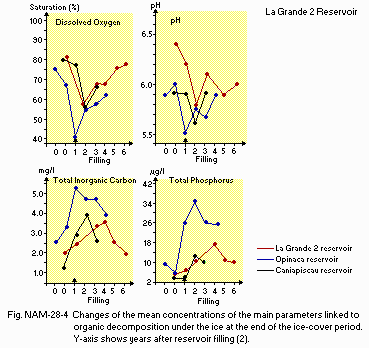
Changes of the mean concentrations of the main parameters linked to organic decomposition under the ice at the end of the ice-cover period (2).
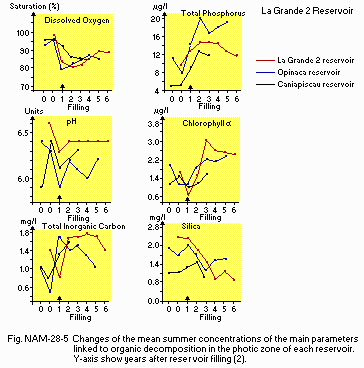
Changes of the mean summer concentrations of the main parameters linked to organic decomposition in the photic zone of each reservoir (2).
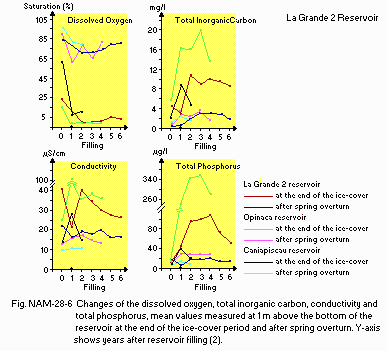
Changes of the dissolved oxygen, total inorganic carbon, conductivity and total phosphorus, mean values measured at 1 m above the bottom of the reservoir at the end of the ice-cover period and after spring overturn (2).
F. BIOLOGICAL FEATURES
F1 FLORAEmerged macrophytes
Aquatic vegetation not well developed due to water level fluctuation (3). Typical vegetation profile among James Bay area rivers before impoundment given in Fig. NAM-28-07 (6); for detailed species list, see (7).
Phytoplankton
List of dominant species before impoundment are given in the following list; for detailed species list, see (7).
Relative abundance of principal phytoplankton species found in James Bay Area in 1973 (6)
| Classes and Species | Percentage by number of cells [%] | |
|---|---|---|
| Diatomophyta | ||
| Asterionella formosa | 6.7 | |
| Eunotia pectinalis | 2.5 | |
| Melosira granulata | 1.0 | |
| M. italica var. subarctica | 0.9 | |
| M. italica | 4.1 | |
| Tabellaria flocculosa | 8.5 | |
| T. flocculosa (f. courte) | 1.4 | |
| T. flocculosa (f. longue) | 10.2 | |
| T. fenestra | 0.2 | |
| Subtotal | 35.7 | |
| Chrysophyta | ||
| Dinobryon bavaricum | 9.6 | |
| D. bavarium var. vanhoffenii | 10.4 | |
| D. divergens | 1.4 | |
| Subtotal | 21.3 | |
| Zygophyta | ||
| Spondylosium planum | 0.4 | |
| Mougeotia sp. | 0.5 | |
| Subtotal | 0.9 | |
| Cyanophyta | ||
| Anabaena flos-aquae | 5.1 | |
| Aphanothece clathrata | 2.2 | |
| Aphanothece sp. | 13.4 | |
| Coelosphaerium kuetzingii | 1.3 | |
| Microcystis aeruginosa | 0.9 | |
| M. minutissima | 3.9 | |
| Merismopedia glauca | 1.2 | |
| Subtotal | 28.0 | |
| Others | Subtotal | 14.0 |
| Total | 100.0 |
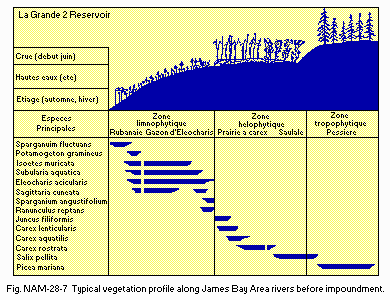
Typical vegetation profile along James Bay Area rivers before impoundment.
F2 FAUNA
Zooplankton
List of dominant species before impoundment are given in the following
table; for detailed species list, see (7).
Relative abundance and occurrence of principal zooplankton species
in the James Bay Area in 1973-74 (6)
| Rank | Species |
|---|---|
| 1 | Bosmina longirostris |
| 2 | Leptodiaptomus minutus |
| 3 | Diacyclops bicuspidatus thomasi |
| 4 | Holopedium gibberum |
| 5 | Kellicottia longispina |
| 6 | Conochilus unicornis |
| 7 | Epischura lacustris |
| 8 | Dapnnia longiremis |
| 9 | Leptodiaptomus sicilis |
| 10 | Aglaodiaptomus spatulocrenatus |
| 11 | Cyclops scutifer |
| 12 | Keratella cochlearis |
| La Grande 2 region | |||
|---|---|---|---|
| Taxa | Reservoir | Control station | |
| 2nd yr. | 3rd yr. | ||
| Nematods | - | 2 | 17 |
| Oligochaetes | 44 | 89 | 79 |
| Leeches | 17 | 24 | 79 |
| Gastropods | 5 | 2 | 100 |
| Pelecypods | 5 | 5 | 54 |
| Water mites | 24 | 50 | 71 |
| Amphipods | 5 | 22 | 83 |
| Mayflies | 5 | 20 | 83 |
| Dragonflies | - | - | 8 |
| Stoneflies | - | 2 | 17 |
| Bugs | 2 | 22 | - |
| Neuroptera | - | - | - |
| Beetles | 10 | 26 | 33 |
| Caddisflies | 7 | 30 | 96 |
| Flies | |||
| Midges | 98 | 100 | 100 |
| Others | 17 | 7 | 29 |
Numbers by species in the basin of La Grande River before impoundment are given in the following table. Relative abundance of fish species after impoundment is shown in Fig. NAM-28-08.
Number of fish captured in the basin of La Grande River in 1973-1976 before flooding of reservoir (6)
| Ft. George | LG1 | LG2 | LG3 | |
|---|---|---|---|---|
| Acipenser fulvescens* | 1 | 15 | 60 | 5 |
| Salvelinus fontinalis* | 206 | 250 | 489 | 56 |
| S. namaycush* | - | - | 62 | 116 |
| Coregonus artedii* | 3,055 | 44 | 340 | 14 |
| C. clupeaformis* | 3,332 | 606 | 743 | 286 |
| Prosopium cylindraceum | 1,144 | 32 | 21 | 27 |
| Esox lucius* | 504 | 242 | 508 | 66 |
| Couesius plumbeus | 1,130 | 208 | 32 | 10 |
| Notropis hudsonius | 31 | 21 | 52 | - |
| Rhinichthys cataractae | 1 | 1 | - | - |
| Semotilus margarita | 7 | - | 34 | - |
| Catostomus catostomus* | 3,406 | 365 | 227 | 131 |
| C. commersoni* | 713 | 110 | 706 | 162 |
| Catostomus sp. | 383 | 518 | 75 | - |
| Lota lota* | 79 | 18 | 30 | 6 |
| Culaea inconstans | 22 | 67 | 52 | - |
| Gasterosteus aculeatus | 10,540 | 4 | 1,109 | - |
| Pungitius pungitius | 1,396 | 13 | 182 | 9 |
| Percopsis omiscomaycus | 575 | 5 | 104 | - |
| Perca flavescens | - | 2 | 124 | - |
| Percina caprodes | - | - | 1 | - |
| Stizostedion vitreum* | 227 | 187 | 676 | 157 |
| Cottus bairdi | 175 | - | 31 | - |
| C. cognatus | - | 1 | 3 | - |
| Myoxocephalus quadricornis | 23 | - | - | - |
| Total | 26,933 | 2,709 | 5,661 | 1,045 |
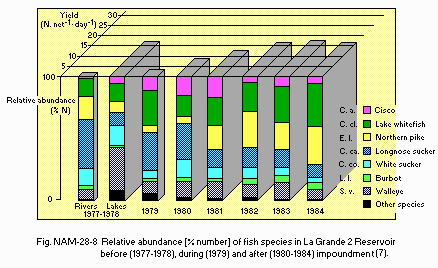
Relative abundance [% number] of fish species in La Grande 2 Reservoir before (1977-1978), during (1979) and after (1980-1984) impoundment (7).
F3 PRIMARY PRODUCTION RATE
Primary productivity [g C m-2 yr-1] observed in La Grande 2 Reservoir
and at the control station, Detcheverry (a natural lake in adjacent area
unaffected by flooding)
| 1981 | 1982 | 1984 | |
|---|---|---|---|
| Bereziuk (LG2) | 63.32 | 60.86 | 20.99 |
| Control station | 13.42 | 19.94 | 7.03 |
| Bereziuk: control station (ratio) | 4.72 | 3.05 | 2.99 |
| Years of flooding | 3 | 4 | 6 |
Zooplankton: Fig. NAM-28-09.
Benthos: Fig. NAM-28-09.
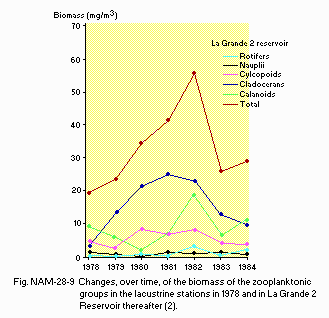
Changes, over time, of the biomass of the zooplanktonic groups in the lacustrine stations in 1978 and in La Grande 2 Reservoir thereafter (2).
F5 FISHERY PRODUCTS (1)
Annual fish catch
No commercial catch. Sport-fishery data not available. Subsistence
fishery reduced to nil after 1985 due to high mercury levels.
F6 PAST TRENDS
Past trends in fish production (catch per unit of effort of experimental
gill nets) is shown in Fig. NAM-28-10.
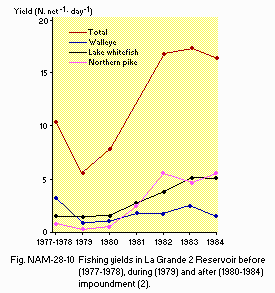
Fishing yields in La Grande 2 Reservoir before (1977-1978), during (1979) and after (1980-1984) impoundment (2).
F7 NOTES ON THE REMARKABLE CHANGES OF BIOTA IN THE LAKE IN RECENT
YEARS
Changes in biota still relatively rapid due to recent formation of
the reservoir.
G. SOCIO-ECONOMIC CONDITIONS (10)
G1 LAND USE IN THE CATCHMENT AREA1976
| Area [%] | |
|---|---|
| Natural landscape* | 100 |
| Agricultural land | 0 |
| Residential area | 0 |
| Total | 100 |
The area is dominated by Picea mariana forest with an undergrowth of Ledum groenlandicum in the lowland area, and by Pinus banksiana with under-carpet of Cladonia lichen on the stony ridges. To the south of the La Grande River, stands of P. mariana with an under.carpet of lichen cover the hilly uplands. There are large areas of scattered muskeg and bog through-out this region. Stands of closed-canopy forest, composed of predominately coniferous trees line some of the rivers and lakes on well-drained land (8, 9). In terms of ecological regions, the area belongs to the Taiga shield ecozone of Canada.
G2 INDUSTRIES IN THE CATCHMENT AREA AND THE LAKE (10)
| Gross product | No.of | Main products or | |
|---|---|---|---|
| per year | persons | major industries | |
| (US$) | engaged | ||
| Primary industry | |||
| Hydro | 1,000 million < | 300 | Electricity |
| -electricity | |||
| Fur production | 1 million > | 20 | Animal skins |
G3 POPULATION IN THE CATCHMENT AREA
None in the catchment area. The town of Radission (about 2,000 in 1988)
is at the edge of basin.
H. LAKE UTILIZATION
H1 LAKE UTILIZATIONSource of water (to temporary camps of hunters and fishermen), hydroelectric generation, navigation and transportation (canoes and small motorboats), sightseeing and tourism (no. of visitors in 1988: estimated 5,000) and recreation (hunting, swimming, sport-fishing, boating).
I. DETERIORATION OF LAKE ENVIRONMENTS AND HAZARDS
I1 ENHANCED SILTATION (3)No data on rate of sedimentation in reservoir. At the discharge of LG2 dam, La Grande River water carries a suspended sediment load of 10 mg l-1 annual average. There is concern about river-bed erosion downstream from LG2 dam.
I2 TOXIC CONTAMINATION
Present status: Serious.
Supplementary notes
There has been a major mercury increase in reservoirs of the La Grande
Complex as a result of impoundment. Concentrations of this heavy metal
increased markedly since flooding of reservoirs. Mercury has been measured
in La Grande 2 predatory and non.predatory fishes at concentrations up
to 0.5 to 3.0 ppm (on wet weight basis, muscle tissue). In Canada, the
allowable level for mercury in fish for human consumption is 0.5 ppm. In
LG2, all fisheries have been closed. The effect is not temporary. "During
the sixth year of the impoundment, mean concentrations were 4 to 5 times
higher on all species studied" (2). The highest levels were found in walleye
(Stizostedion vitreum) and northern pike (Esox lucius), thus ruining the
recreational fishery potential of the reservoir. No deleterious health
effects of consuming fish have been detected in the native Amerindians
of the area. Since the end of 1985, these people have been avoiding fish
from the area of reservoirs (l). While the source of this mercury is controversial,
presumably it comes from natural sources; that is, rocks of the Canadian
Shield. There may be some airborne sources of mercury as well; role of
acidification in increased uptake of mercury by biota is being investigated.
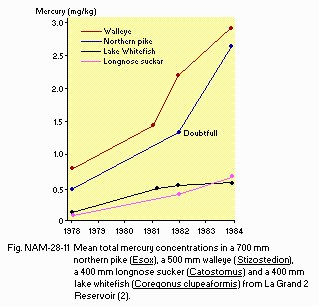
(2) Mean total mercury concentrations in a 700 mm northern pike (Esox), a 500 mm walleye (Stizostedion), a 400 mm longnose sucker (Catostomus) 0 and a 400 mm lake whitefish (Coregonus clupeaformis) from La Grande 2 Reservoir.
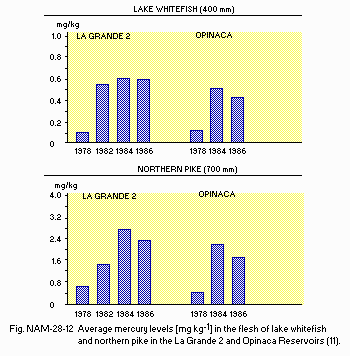
(11) Average mercury levels [mg kg-1] in the flesh of lake whitefish and northern pike in the La Grande 2 and Opinaca Reservoirs.
I3 EUTROPHICATION
Nuisance caused by eutrophication: None.
Supplementary notes
Natural eutrophication only (the area is naturally oligotrophic). After
impoundment, the reservoir responded with a trophic upsurge commonly reported
for the early years of any reservoir's life. Total phosphorus increases
lead to increases in chlorophyll a, zooplankton biomass and even fish yields.
If LG2 responds as other reservoirs, the trophic status will slowly change
from its present oligotrophic/mesotrophic status to the mid. oligotrophic
range. I4 ACIDIFICATION
No systematic data available.
J. WASTEWATER TREATMENTS
None in area.M. LEGISLATIVE AND INSTITUTIONAL MEASURES FOR UPGRADING LAKE ENVIRONMENTS (Q)
M1 NATIONAL AND LOCAL LAWS CONCERNEDNames of the laws (the year of legislation)
- La Loi de la Quality de l'Environment (1978)
- James Bay and Northern Quebec Agreement (1975)
- Mercury Agreement (1986) Responsible authorities
- Government of Quebec, Ministry of Environment
- Hydro-Quebec, Governments of Quebec and Canada
- Societe d'Energie de la Baie James; Quebec and Canada
- Hydro-Quebec; Government of Quebec Main items of control
- Environmental impacts
- Impacts from reservoir management
- Impacts from reservoir construction
- High mercury levels in fish
- l) Societe d'Energie de la Baie James
- Hydro-Quebec
- l) Environment departments of the above agencies
N. SOURCES OF DATA
- Questionnaire filled by Drs. M. Kislalioglu & F. Berkes, Institute of Urban and Environmental Studies, Brock University, St. Catharines, Ontario. l) Berkes, F. (1988) The intrinsic difficulty of predicting impacts: lessons from the James Bay Hydro project. Environmental Impact Assessment Review, 8: 201-220.
- Roy, D., Laperle, M., Boudreault, J., Boucher, R., Schetagne, R. & Therien, N. (1986) Ecological Monitoring Program of the La Grande Complex 1978-1984. Summary Report. Societe d'Energie de la Baie James, Montreal.
- Sur Equipment de l'Amenagement de La Grande 2. Rapport sur les Etudes d'Avant-projet. Volume 3 (1985) Hydro-Quebec/Societe d'Energie de la Baie James, Montreal.
- ) Canadian Climate Normals, 1951-1980. Environment Canada, Atmospheric Environment Service.
- Boucher, R. & Schetagne, R. (1983) Repercussions de la Mise en Eau des Reservoirs de La Grande 2 et Opinaca sur la Concentration de Mercure dans les Poissons. Societe d'Energie de la Baie James, Montreal.
- Nault, R. (1980) Surveillance ecologique intensive du Reservoir de LG2. Eau du Quebec, 13 (1): 33-43.
- Connaissance du Milieu des Territoires de la Baie James et du Nouveau- Quebec (1978) Societe d'Energie de la Baie James, Montreal.
- Magnin, E. (1977) Ecologie des Faux Douces du Territoire de la Baie James. Societe d'Energie de la Baie James, Montreal.
- Rowe, J. S. (1972) Forest Regions of Canada. Canadian Forest Service, Department of the Environment, Ottawa.
- Environmental Studies, James Bay Territory, 1972-1979, Summary Report (1982) Societe de Development de la Baie James/Environment Canada, Ottawa.
- Orientation du Development et de l'Amenagement du Territoire de la Baie James (1980) Societe de Development de la Baie James, Montreal.
- James Bay Mercury Committee, Report of Activities, 1987-1988.


